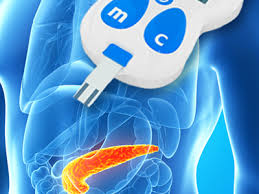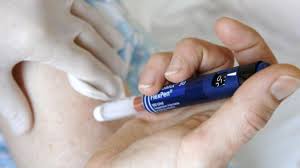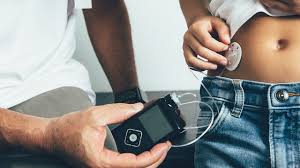
Diabetes is a chronic disease associated with abnormally high levels of sugar(glucose) in the blood. Insulin produced by the pancreas lowers blood glucose. Absence or insufficient production of insulin, or an inability of the body to properly use insulin causes diabetes. Diabetes is a multi-system disease. This means that it can affect multiple organs.
General symptoms of Diabetes

General symptoms of diabetes include:
- Increased hunger
- weight loss
- Increased hunger
- Frequent urination
- Extreme fatigue
- Blurry vision
- Sores that don’t heal
Additionally, men with diabetes tend to have decreased sex drive, erectile dysfunction(ED), and poor muscle strength.
Types of Diabetes

There are three main types of diabetes:
- Type 1 Diabetes (Insulin-dependent diabetes)
This type of diabetes used to be called juvenile-onset diabetes because it often begins in childhood.
Type 1 diabetes is an autoimmune condition. It happens when your body attacks your pancreas with antibodies. The organ is damaged and doesn’t make insulin.
Your genes might cause this type of diabetes. It could also happen because of problems with cells in your pancreas that make insulin.
Many of the health problems that can come with type 1 happen because of damage to tiny blood vessels in your eyes (called diabetic retinopathy), nerves (diabetic neuropathy), and kidneys (diabetic nephropathy). People with type 1 also have a higher risk of heart disease and stroke.
Symptoms
- Increased thirst
- extreme hunger
- increased thirst
- unintentional weight loss
- Frequent urination
- blurry vision
- tiredness
Treatment

Treatment of type 1 diabetes involves injecting insulin into the fatty tissue under your skin. You might use: syringes, Jet injectors that use high-pressure air to send a spray of insulin through your skin, and Pumps that send insulin through a tube to a catheter under the skin of your belly
A test called the A1C blood test estimates your blood sugar levels over the previous three months. Your doctor uses it to see how well your blood sugar is controlled. That helps them know your risk of complications.
If you have type 1 diabetes, you’ll need to make changes including:
- Frequent testing of your blood sugar levels
- Careful meal planning
- Daily exercise
- Taking insulin and other medications as needed
- Type 2 Diabetes
Type 2 diabetes used to be called non-insulin-dependent or adult-onset diabetes.
But it’s become more common in children and teens over the past 20 years, largely because more young people are overweight or obese. About 90% of people with diabetes have type 2.
When you have type 2 diabetes, your pancreas usually creates some insulin. But either it’s not enough or your body doesn’t use it like it should. Insulin resistance, when your cells don’t respond to insulin, usually happens in fat, liver, and muscle cells.
Type 2 diabetes is often milder than type 1. But it can still cause major health complications, especially in the tiny blood vessels in your kidneys, nerves, and eyes. Type 2 also raises your risk of heart disease and stroke.
People who are obese — more than 20% over their target body weight for their height — have an especially high risk of type 2 diabetes and the health problems that can follow. Obesity often causes insulin resistance, so your pancreas has to work harder to make more insulin. But it’s still not enough to keep your blood sugar levels where they should be.
Symptoms
- increased hunger
- increased thirst
- increased urination
- blurry vision
- tiredness
- sores that are slow to heal
Treatment

Treatment of type 2 diabetes involves:
- Keeping healthy weight
- Eating right
- Exercising
- Medication
- Gestational Diabetes
Pregnancy usually causes some form of insulin resistance. If this becomes diabetes, it’s called gestational. Doctors often spot it in middle or late pregnancy. Because a woman’s blood sugars travel through her placenta to the baby, it’s important to control gestational diabetes to protect the baby’s growth and development.
Doctors report gestational diabetes in 2% to 10% of pregnancies. It usually goes away after birth. But up to 10% of women who have gestational diabetes get type 2, weeks or even years later.
Treatment

Treatment of gestational diabetes include:
- Careful meal planning to make sure you get enough nutrients without too much fat and calories
- Daily exercise
- Keeping weight gain under control
- Taking insulin to control your blood sugar levels, if needed
Diabetes Risk Factors

There are several risk factors that can increase your risk for diabetes:
Type 1 Diabetes
You’re more likely to get type 1 diabetes if you’re a child or teenager, you have a parent or sibling with the condition, or you carry certain genes that are linked to the disease.
Type 2 Diabetes
Your type 2 diabetes risk will increase if:
- are overweight
- are age 45 or older
- have a parent or sibling with the condition
- aren’t physically active
- have had gestational diabetes
- have prediabetes
- have high blood pressure, high cholesterol, or high triglycerides
- have African American, Hispanic or Latino American, Alaska Native, Pacific Islander, American Indian, or Asian American ancestry
Gestational Diabetes
Your risk for gestational diabetes increases if you:
- are overweight
- are over age 25
- had gestational diabetes during a past pregnancy
- have given birth to a baby weighing more than 9 pounds
- have a family history of type 2 diabetes
- have polycystic ovary syndrome (PCOS)
Diabetes Complications

High blood sugar damages organs and tissues throughout your body. The higher your blood sugar is and the longer you live with it, the greater your risk for complications.
Complications include:
- Heart attack or stroke
- Neuropathy
- Nephropathy
- Hearing loss
- Depression
- Dementia
- Foot damage such as infections and sores that don’t heal
- Skin conditions such as bacterial and fungal infections
Gestational Diabetes
- Premature birth
- Higher-than-normal weight at birth
- increased risk for type 2 diabetes later in life
- Low blood sugar
- Jaundice
- stillbirth
Diabetes and Diet

Type 1 Diabetes
Your blood sugar level rises or falls based on the types of foods you eat. Starchy or sugary foods make blood sugar levels rise rapidly. Protein and fat cause more gradual increases.
Your medical team may recommend that you limit the amount of carbohydrates you eat each day. You’ll also need to balance your carb intake with your insulin doses.
Work with a dietitian who can help you design a diabetes meal plan. Getting the right balance of protein, fat, and carbs can help you control your blood sugar.
Type 2 Diabetes
Eating the right types of foods can both control your blood sugar and help you lose any excess weight.
Carb counting is an important part of eating for type 2 diabetes. A dietitian can help you figure out how many grams of carbohydrates to eat at each meal.
In order to keep your blood sugar levels steady, try to eat small meals throughout the day. Emphasize healthy foods such as:
- Fruits
- Vegetables
- Whole Grains
- lean protein such as poultry and fish
- Healthy fats such as olive oil and nuts
Certain other foods can undermine efforts to keep your blood sugar in control. Discover the foods you should avoid if you have diabetes.
Gestational Diabetes
Eating a well-balanced diet is important for both you and your baby during these nine months. Making the right food choices can also help you avoid diabetes medications.
Watch your portion sizes, and limit sugary or salty foods. Although you need some sugar to feed your growing baby, you should avoid eating too much.
Consider making an eating plan with the help of a dietitian or nutritionist. They’ll ensure that your diet has the right mix of macronutrients.
